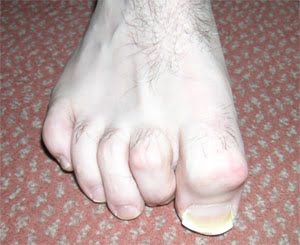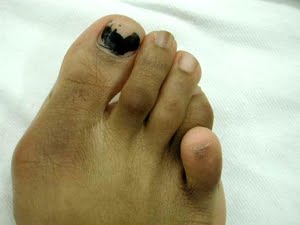Introduction
There are many types of lesser toe deformities, including hammer, claw, mallet and cross-over toe deformities. The big toe is known as the hallux and all the others are referred to as the lesser toes.
Some people are born with abnormalities of the lesser toes, but the majority develops during adult life, particularly but not exclusively in old age.
Causes of Deformed Toes
In the first stages, the patient will often complain of pain under the ball of the foot which is very unpleasant, and present with every step. There is localised swelling, and a bare foot is usually more uncomfortable than a cushioned shoe. A high heeled, thin-soled shoe is usually the worse form of footwear to wear.
The commonest toe to be affected is the 2nd toe and there is always an underlying mechanical reason for this. Hammer 2nd toes are associated with long 2nd metatarsals compared to the 1st, hallux valgus deformities (bunions) and tight calf musculature
A hammertoe results from mechanical failure of the so-called MTP or metatarsophalangeal joint, located at the point where the toe is connected to the foot. Usually, after a period of pain in the ball of the foot, the toe rapidly deforms. This is due to the rupture of a structure called the plantar plate.
When it deforms, the foot can become less painful, but this is usually temporary. Eventually pain in the ball of the foot can reappear and the toe will start to rub on shoes and can be very painful indeed.
A hammertoe is most commonly associated with a bunion, but not necessarily so. In the past hammertoe often arose as a result of inappropriate or inadequately performed surgery on the big toe.
Claw toe
A claw toe may look similar to a hammer toe but rarely occurs in isolation: a claw toe arises as a result of a neurological (nerve) disorder and therefore normally all the toes of one or both feet are affected.


Mallet toe
A mallet toe is due to an excessively tight flexor tendon and is the easiest condition affecting lesser toes to be treated.


Cross-over toe
A cross-over toe can be a variant of a hammer toe but when present at birth, almost invariably affects the little toe.


Other conditions
There are a number of rarer deformed toes conditions where lesser toes can be excessively short, long, big or bent. Deformed toes can come in all shapes and sizes and should not be ignored.
Deformed Toes Treatment
Treatment of all of these problems can be non-operative or operative but it is important to make a correct diagnosis and to understand the underlying mechanism that has led to the deformity. For example operating on a hammer toe that has arisen as a result of a bunion will not be successful unless the bunion is addressed at the same time.
Likewise, the cause of clawing of the toes should never go un-investigated, as the underlying neurological condition needs to be identified so that treatment and expectations can be managed in an optimal way.
Once appropriate investigations have been completed, the condition can be treated.
Non-surgical treatment
Non-operative management of lesser toe deformities include advice on footwear, dealing with corns and callosities and the use of protective silicone sleeves to avoid pressure and rubbing.
Surgical treatment
Operative treatment involves correction of the deformed toes and at the same time, addressing the mechanical cause of the underlying problem. Surgery can be performed under local or general anaesthesia and for many lesser toe problems, a temporary wire in the toe will be required for four to six weeks.
Whilst this is inconvenient, the problem with lesser toe deformities is that they generally get worse with time and appropriate intervention to correct the problem can save a lot of trouble in the future.




